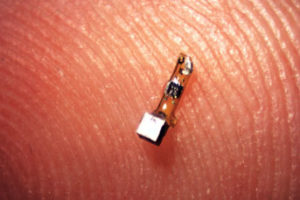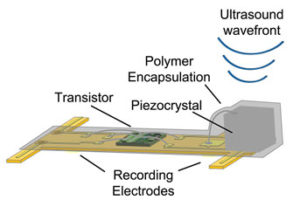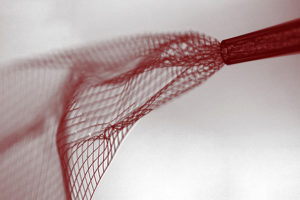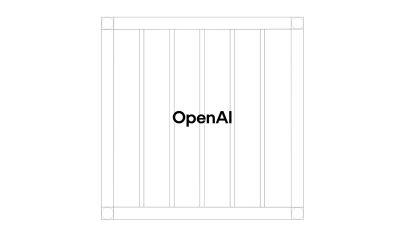

Lifestyle
Neuralink: Elon Musk’s vanguard against human obsolescence
Neuralink, Musk’s brain-computer interface company, is in the process of expanding rapidly and has several new technical job openings on their website. There is heavy focus on applied engineering, particularly in the context of microelectromechanical systems (MEMS), also known as micromachines or “really tiny robots”, as I like to call them. Not only is this a rapidly growing field of study and application as of late, but MEMS as a priority implies that in the near term, Neuralink is structuring itself as an advanced nanotechnology incubator, with a focus on biocompatible (safe for humans) applications.
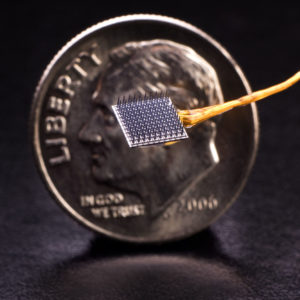
A traditional, state-of-the-art 100 electrode array. This is implanted directly into the brain by way of open-brain surgery. (Matthew McKee, Brown University)
MEMS have a fascinating history, often said to have begun with a famous lecture given by Richard Feynman in 1959. In it, he argued that it should be fundamentally possible to one day manipulate matter at an atomic level, to “arrange atoms the way we want”. All matter is composed of atomic structures, and such a capability would logically allow the creation of new materials and chemicals by mechanically altering atomic structures. Technology on this order would allow for the existence of science fiction standouts like true 3D printers capable of assembling almost anything conceivable (food, functioning electronic devices, clothing, pharmaceuticals, etc.) out of some form of basic input matter. That capability is of course purely theoretical and probably decades away from reality, but it offers an idea as to just how useful atomic manipulation could be in nearly every industry one can imagine.
For brain-computer interfaces (BCIs), the allure of MEMS or nano-EMS (NEMS) are obvious. Given small enough machines, one can imagine a sort of biocompatible dust that would naturally proliferate throughout the brain and body, likely by way of the bloodstream. Confused for nutrients or debris, many millions or billions of these tiny dust particles might embed themselves in the vast network of blood vessels throughout the human brain or be absorbed into neurons themselves. Add some sort of mesh network capability or an external device capable of interacting with the smart dust, and you have a vast, detailed method of recording and stimulating neural activity with something as simple as a few pills or injections and a smartphone-sized device.
The minds behind Neuralink
While even the narrower goal sketched above appears far fetched in many ways, the eight founding members of Neuralink have backgrounds that suggest the company will pursue precisely that architecture, often called “neural dust”. Several have conducted critical research into the many complex ways human brains integrate information necessary to move the body, among other things. Phillip Sabes, a professor of physiology at the University of California (San Francisco), has conducted research into the brain’s ability to “flexibly and adaptively integrate information from a variety of sources, from higher cognition to sensory and motor processing”. This information integration is a fundamental feature of all brain function.
Several other founders have experience in neuromorphic (brain-like) computer processors. Paul Merolla has been a central designer in almost every groundbreaking neuromorphic chip project, ranging from Stanford’s Neurogrid and IBM’s TrueNorth. In general, the study of neuromorphic computing hopes to package some of the incredible efficiencies and capabilities of brains into commercial products. Primarily, neuromorphic engineering attempts to replicate the behavior of biological neural networks in order to better understand them and, as a result, better understand how the human mind functions.
The lab Sabes runs has been recently exploring an array of topics, ranging from efforts to drastically improve researchers’ abilities to listen to neurons in the brain, to developing knowledge and technologies that could eventually provide natural movement and control through brain-machine interfaces (i.e. brain-controlled prosthetic limbs) by introducing artificial feedback. The argument his lab makes is that the unnatural look and feel of people using brain-interfaced prosthetics is likely a result of a lack of feedback in the artificial limbs, where real human limbs are typically directed with a combination of multiple senses like touch, temperature, pressure, and more. Possibly the most important conclusion is that through the work his lab does, they are “learning how to communicate with parts of the brain that don’t have a clear topology (location or distribution), which is most of the brain”. For Neuralink to have even a chance of successfully developing a “high bandwidth interface for the nervous system”, this knowledge will be crucial, given the fact that higher cognitive functions tend to be broadly distributed throughout the physical brain.
Other members, like Tim Hanson, have spent the better part of a decade developing flexible, stable, and minimally-invasive alternatives to the rigid electrodes of today, which require inherently risky surgery to install. These flexible electrodes, capable of being more or less “injected” into the brain, have been successfully tested numerous times in animal subjects and are currently undergoing tests to ensure their longevity and resilience to the tough environment of living things.
Heading back to the concept of “neural dust” and other innovative methods of recording and stimulating neurons, another of the eight founders of Neuralink is Dr. Dongjin Seo, a central figure in the exploration of “neural dust”. Described as “ultra-miniature, untethered, wireless neural implants (‘Neural Dust’) for brain-machine interfaces”, Seo and several others have spent years developing the concept. Most recently, Seo and six other researchers successfully conducted testing in rats of a preliminary prototype of neural dust that was passive, wireless, and had no batteries. By powering the ‘dust motes’ with ultrasound while implanted in brain tissue, the researchers were able to produce detailed, accurate recordings of rat brain activity. This successful proof of concept occurred in 2016, and it is undoubtedly no coincidence that Seo was invited just months later to co-found Neuralink with Elon Musk.
- Dr. Seo’s neural dust prototype. The longest dimension is approximately 1 millimeter. (Berkeley Labs)
- A zoomed-in diagram of the dust mote pictured to left.
- An alternative non-invasive electrode, in the form of an injectable mesh. (Lieber Research Group)
While there is a vast amount of progress and miniaturization that must occur before anything approaching Musk’s aspirations is possible, the very fact that non-invasive neural recording and stimulation could be achievable in humans within a handful of years puts into doubt a great deal of specific criticism Neuralink and Musk have received since the reveal.
Bandwidth
Another difficulty in creating a “high bandwidth interface for the nervous system” lies in the high-bandwidth aspect of the endeavor. In order to functionally interact with an array of neurons, say even a million neurons, a vast amount of data will have to be transferred very rapidly, and wirelessly, back and forth between brains and computers. The creation of true, seamless BCIs will likely require observing and stimulating tens of millions to billions of neurons. If we assume that a single neuron would create around 5,000 bytes (5 kilobytes) of information per second, and we want to observe ten million neurons simultaneously, the bandwidth necessary can begin to reach well into the range of terabits (~120 gigabytes) per second. It’s possible that this issue can be circumvented by communicating and stimulating fewer neurons per second or solved with some form of compression between brain and computer, but it serves to illustrate the incredible scale of the brain and the difficulties of creating an interface worthy of the title “high bandwidth” in context.
It should thus come as no surprise that Dr. Seo has assisted in the development of extremely high bandwidth, short range wireless communications in the past. Every single member of the Neuralink team was aggressively vetted and narrowed down to a select few individuals who were experts in multiple highly complex fields each. Musk told that Wait But Why‘s Tim Urban that he likely personally interviewed or met with at least a thousand people before deciding upon the eight initial founding members. Many of the founders Musk originally approached left sought-after tenured positions at prestigious institutions to join Neuralink, and this speaks to Musk and Neuralink’s highly compelling goals.
The human brain is thought to contain as many as 100 billion neurons, at least 20% of which are relevant to the higher-level cognition that is unique to humans, and possibly a trillion or more glial cells which may play a far more significant role in cognition than previously thought. Ahead of Neuralink and the brilliant team are numerous vast and undeniably daunting challenges. As they have before, they will continue to peer deep within the abysses of human consciousness and attempt to progress our understanding of ourselves. Whether they succeed or fail, they will do so for the sake of the future of humanity; endeavoring to improve upon a chaotic natural marvel and hoping to ensure competition in the face of artificial intelligence that will know no biological bounds.
Lifestyle
EV fans urge Tesla to acquire Unplugged Performance for edge in fleet and security industry
Unplugged Performance has built a name for itself by producing performance upgrades for Tesla vehicles.

A growing number of Tesla enthusiasts and longtime community voices are calling on the electric vehicle maker to acquire Unplugged Performance, a California-based aftermarket company best known for tuning Tesla vehicles and developing specialized government fleet solutions under its UP.FIT division.
The idea was once considered a niche proposal among EV fans, but it is now gaining serious attention not just as a performance play but as a strategic move to deepen Tesla’s roots in the fleet and security industry.
A strategic fit
Unplugged Performance has built a name for itself by producing performance upgrades for Tesla vehicles, from track-optimized components to visual and aerodynamic upgrades. But in recent years, its UP.FIT division has pivoted toward a more functional future by outfitting Tesla vehicles like Model Ys for police, military, and government use.
That work has sparked growing calls for closer collaboration with Tesla, especially as the EV maker increasingly leans into autonomy, AI, and fleet services as core components of its next chapter.
“I posted this four years ago, but I think it’s more true now than ever,” wrote Whole Mars Catalog, a well-known Tesla investor and FSD Beta tester, on X. “Tesla should buy Unplugged. But not just as a Performance division. What they are doing with UP.FIT unlocks large government and commercial fleet purchases that can improve utilization.”
Tesla fans such as shareholder Sawyer Merritt echoed the sentiment, calling Unplugged a “great fit within Tesla.” adding, “They are literally located directly next to Tesla’s design studio in Hawthorne.”
Enabling the next wave
Supporters of the idea noted that integrating Unplugged into Tesla’s corporate structure could help accelerate the adoption of autonomous technologies in government sectors. With UP.FIT patrol cars already in use across some U.S. police departments, Tesla fans envisioned a future where self-driving Teslas could potentially revolutionize law enforcement, search-and-rescue, and public service logistics.
“Just imagine how autonomous patrol cars could transform policing and bring us into a safer future,” the veteran FSD tester wrote.
The benefits could also extend to Tesla’s existing consumer base. “They also have some incredible products in the works that I think will appeal to many ordinary Tesla drivers — not just those looking for performance or mods. Stuff that’s so good it should have come straight from the design studio next door,” Whole Mars Catalog noted.
Unplugged Performance, founded in 2013, shares not just a product vision with Tesla, but also geography. Its Hawthorne headquarters sits directly adjacent to Tesla’s design studio, and the two companies have maintained a close working relationship over the years. The aftermarket firm has long positioned itself as a “mission-aligned” partner to Tesla.
In response to the recent calls for acquisition, Unplugged Performance acknowledged the support from the community. “Our very existence is to support the Tesla mission with @UpfitTesla and @UnpluggedTesla,” Unplugged CEO Ben Schaffer posted on X. “We love working with Tesla and are grateful for the community’s support since 2013!”
Elon Musk
X account with 184 followers inadvertently saves US space program amid Musk-Trump row
Needless to say, the X user has far more than 184 followers today after his level-headed feat.

An X user with 184 followers has become the unlikely hero of the United States’ space program by effectively de-escalating a row between SpaceX CEO Elon Musk and President Donald Trump on social media.
Needless to say, the X user has far more than 184 followers today after his level-headed feat.
A Near Fall
During Elon Musk and Donald Trump’s fallout last week, the U.S. President stated in a post on Truth Social that a good way for the United States government to save money would be to terminate subsidies and contracts from the CEO’s companies. Musk responded to Trump’s post by stating that SpaceX will start decommissioning its Dragon spacecraft immediately.
Musk’s comment was received with shock among the space community, partly because the U.S. space program is currently reliant on SpaceX to send supplies and astronauts to the International Space Station (ISS). Without Dragon, the United States will likely have to utilize Russia’s Soyuz for the same services—at a significantly higher price.
X User to the Rescue
It was evident among X users that Musk’s comments about Dragon being decommissioned were posted while emotions were high. It was then no surprise that an X account with 184 followers, @Fab25june, commented on Musk’s post, urging the CEO to rethink his decision. “This is a shame this back and forth. You are both better than this. Cool off and take a step back for a couple days,” the X user wrote in a reply.
Much to the social media platform’s surprise, Musk responded to the user. Even more surprising, the CEO stated that SpaceX would not be decommissioning Dragon after all. “Good advice. Ok, we won’t decommission Dragon,” Musk wrote in a post on X.
Not Planned, But Welcomed
The X user’s comment and Musk’s response were received extremely well by social media users, many of whom noted that @Fab25june’s X comment effectively saved the U.S. space program. In a follow-up comment, the X user, who has over 9,100 followers as of writing, stated that he did not really plan on being a mediator between Musk and Trump.
“Elon Musk replied to me. Somehow, I became the accidental peace broker between two billionaires. I didn’t plan this. I was just being me. Two great minds can do wonders. Sometimes, all it takes is a breather. Grateful for every like, DM, and new follow. Life’s weird. The internet’s weirder. Let’s ride. (Manifesting peace… and maybe a Model Y.)” the X user wrote.
Lifestyle
Tesla Cybertruck takes a bump from epic failing Dodge Charger
The Cybertruck seemed unharmed by the charging Charger.
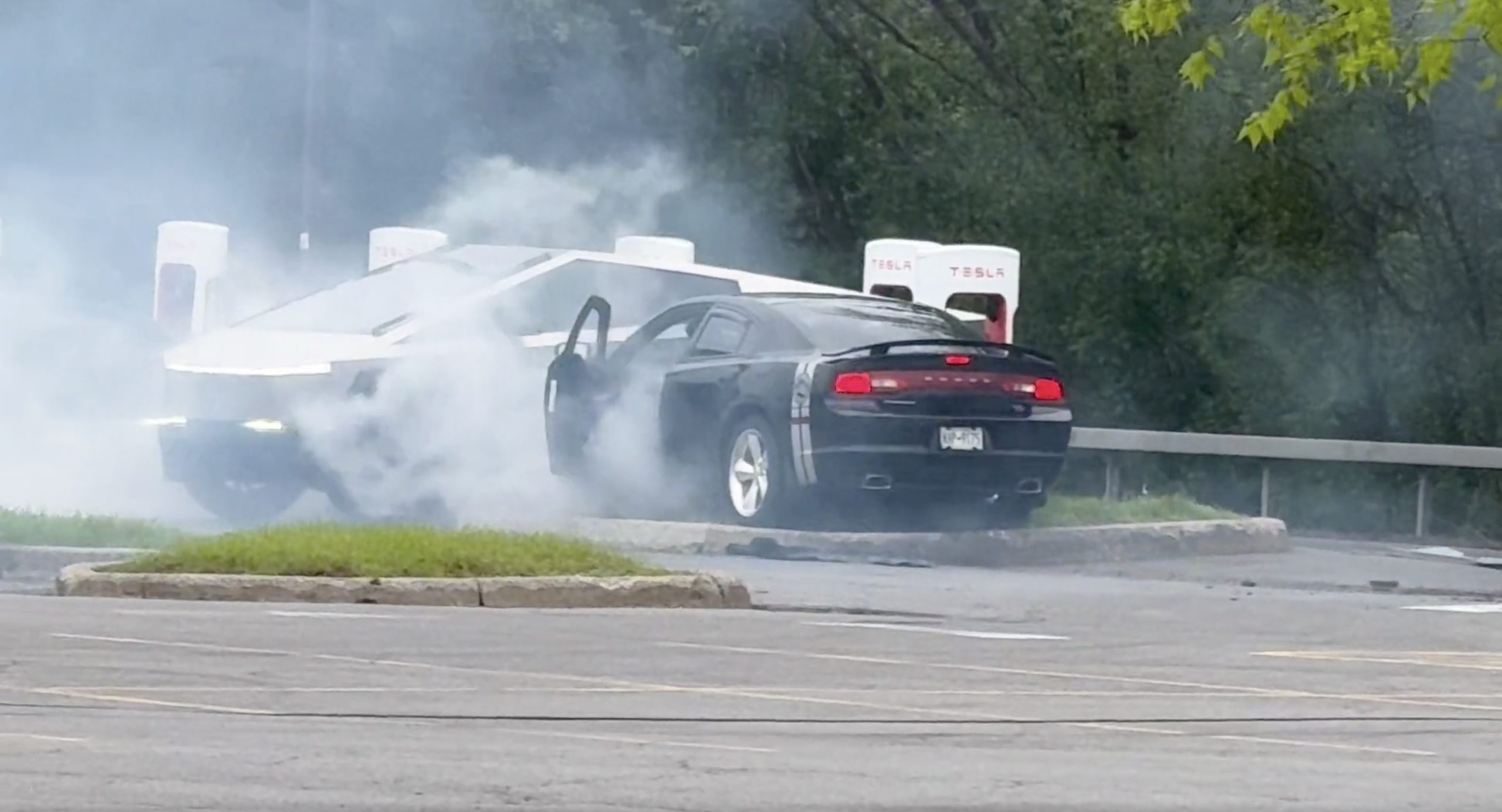
There comes a time in a driver’s life when one is faced with one’s limitations. For the driver of a Dodge Charger, this time came when he lost control and crashed into a Tesla Cybertruck–an absolute epic fail.
A video of the rather unfortunate incident was shared on the r/TeslaLounge subreddit.
Charging Charger Fails
As could be seen in the video, which was posted on the subreddit by Model Y owner u/Hammer_of_something, a group of teens in a Dodge Charger decided to do some burnouts at a Tesla Supercharger. Unfortunately, the driver of the Charger failed in his burnout or donut attempt, resulting in the mopar sedan going over a curb and bumping a charging Cybertruck.
Ironically, the Dodge Charger seemed to have been parked at a Supercharger stall before its driver decided to perform the failed stunt. This suggests that the vehicle was likely ICE-ing a charging stall before it had its epic fail moment. Amusingly enough, the subreddit member noted that the Cybertruck did not seem like it took any damage at all despite its bump. The Charger, however, seemed like it ran into some trouble after crashing into the truck.
Alleged Aftermath
As per the the r/TeslaLounge subreddit member, the Cybertruck owner came rushing out to his vehicle after the Dodge Charger crashed into it. The Model Y owner then sent over the full video of the incident, which clearly showed the Charger attempting a burnout, failing, and bumping into the Cybertruck. The Cybertruck owner likely appreciated the video, in part because it showed the driver of the Dodge Charger absolutely freaking out after the incident.
The Cybertruck is not an impregnable vehicle, but it can take bumps pretty well thanks to its thick stainless steel body. Based on this video, it appears that the Cybertruck can even take bumps from a charging Charger, all while chilling and charging at a Supercharger. As for the teens in the Dodge, they likely had to provide a long explanation to authorities after the incident, since the cops were called to the location.
-

 Elon Musk2 weeks ago
Elon Musk2 weeks agoTesla investors will be shocked by Jim Cramer’s latest assessment
-

 News2 days ago
News2 days agoTesla debuts hands-free Grok AI with update 2025.26: What you need to know
-

 Elon Musk4 days ago
Elon Musk4 days agoxAI launches Grok 4 with new $300/month SuperGrok Heavy subscription
-

 Elon Musk7 days ago
Elon Musk7 days agoElon Musk confirms Grok 4 launch on July 9 with livestream event
-

 News1 week ago
News1 week agoTesla Model 3 ranks as the safest new car in Europe for 2025, per Euro NCAP tests
-

 Elon Musk2 weeks ago
Elon Musk2 weeks agoxAI’s Memphis data center receives air permit despite community criticism
-

 News4 days ago
News4 days agoTesla begins Robotaxi certification push in Arizona: report
-

 News2 weeks ago
News2 weeks agoTesla sees explosive sales growth in UK, Spain, and Netherlands in June

